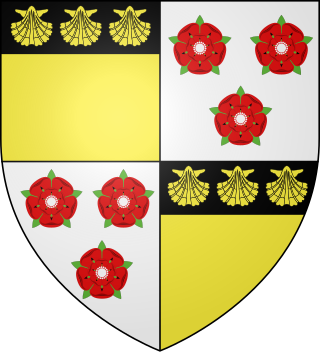Related Research Articles

The title Lord Forrester was created in the Peerage of Scotland in 1633 for Sir George Forrester, Bt who had already been created a baronet in the Baronetage of Nova Scotia in 1625. When his only son died, Forrester was given a regrant of the peerage in 1651 with special remainders:

Edward Chichester, 1st Viscount Chichester of Eggesford in Devon, was Governor of Carrickfergus and Lord High Admiral of Lough Neagh, in Ireland.
Sir Robert Lauder of the Bass was a Scottish knight, armiger, and Governor of the Castle at Berwick-upon-Tweed. He was also a member of the old Scottish Parliament. The Lauders held the feudal barony of The Bass, East Lothian, Edrington Castle and lands in the parish of Mordington, Berwickshire, Tyninghame in Haddingtonshire, and numerous other estates and properties elsewhere in Scotland.

Clan Cranstoun is a family of the Scottish Lowlands.

Clan Oliphant is a Highland Scottish clan.

Sir William Douglas "le Hardi", Lord of Douglas was a Scottish nobleman and soldier.
Alexander Leslie, Earl of Ross was a Scottish nobleman. Born between 1367 and 1382, he was the son of Walter Leslie, Lord of Ross and Euphemia I, Countess of Ross. In around 1394, or not later than 1398, he became Earl of Ross and sometime before 1398 he married Isabel Stewart, daughter of Robert Stewart, Earl of Fife who became Robert Stewart, Duke of Albany. They had one child, Euphemia. He died at Dingwall, Scotland on 8 May 1402.

Alexander Seton, 1st Earl of Huntly, who adopted the family name of Gordon from about 1457, was a powerful 15th-century Scottish magnate. He was knighted in 1439/1440 and was Lord of Badenoch, Gordon, Strathbogie and Cluny.
William Cranstoun, 3rd Lord Cranstoun was a Scottish Lord of Parliament and a renowned Cavalier.
Janet Beaton, Lady of Branxholme and Buccleugh (1519–1569) was an aristocratic Scottish woman and a mistress of James Hepburn, Earl of Bothwell. She had a total of five husbands. One of her nieces was Mary Beaton, one of the four ladies-in-waiting of Mary, Queen of Scots, known in history as the four Marys. In her lifetime, she was accused of having been a witch. Janet was immortalised as Sir Walter Scott's Wizard Lady of Branxholm in his celebrated narrative poem "Lay of the Last Minstrel".

Sir Walter Scott, 1st of Branxholme, 3rd of Buccleuch, known as "Wicked Wat", was a nobleman of the Scottish Borders and the chief of Clan Scott who briefly served as Warden of the Middle March He was an "inveterate English hater" active in the wars known as The Rough Wooing and a noted Border reiver. He was killed on Edinburgh High Street in a feud with Clan Kerr in 1552. His great-grandson was Sir Walter Scott, 1st Lord Scott of Buccleuch, the "Bold Buccleuch" (1565–1611), a border reiver famed for his role in the rescue of Kinmont Willie Armstrong.
William Cranstoun, 1st Lord Cranstoun was a Scottish Lord of Parliament, who played a prominent part in the pacification of the Anglo-Scottish border in the early 17th century.

William Graham, 1st Earl of Montrose was a Scottish Lord of Parliament, who was raised to an earldom by James IV of Scotland and who died with his monarch at the Battle of Flodden.

The Barony of Glengarnock is a Scottish feudal barony in the county of Ayrshire in Scotland.
James Balfour, 1st Baron Balfour of Glenawley or Clonawley was a Scottish nobleman and courtier who was one of the chief undertakers in the Plantation of Ulster. His third marriage to Anne Blayney caused a notable scandal.

John Hamilton, 1st Lord Bargany was a Scottish peer.
James Lindsay, 7th Lord Lindsay PC, Scottish landowner who was a gentleman of King James's bedchamber.

Sir James (de) Lindsay, 9th Lord of Crawford, Knight Banneret, Lord of Crawford, Kirkmichael, Wigton, Symontoun, and of many other baronies, claiming also to be Lord of Buchan, was a Scottish feudal lord.
John Lindsay, 8th Lord Lindsay PC, was a Scottish landowner.
Robert Lindsay, 9th Lord Lindsay PC, was a Scottish landowner.